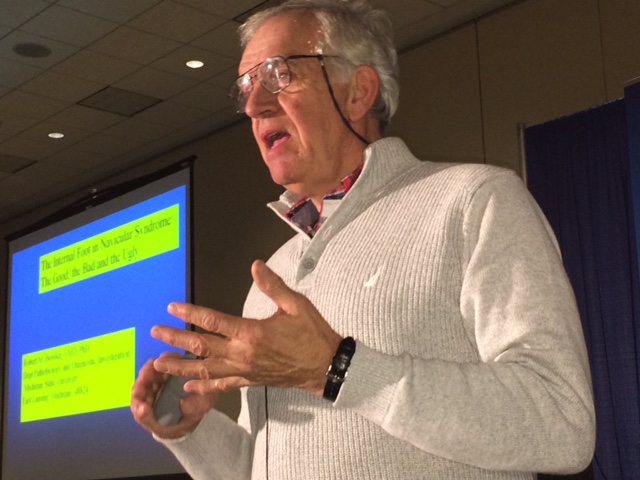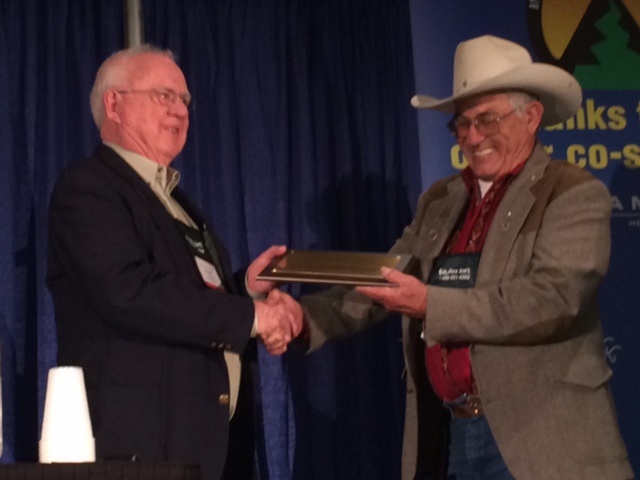The debate has been raging for quite some time — should a horse go barefoot or shod? On the third day of the International Hoof-Care Summit in Cincinnati, Ohio, Dr. Stephen O’Grady answered that question.
“The equine foot with good healthy structures in its natural state is far superior at accepting the weight of the horse, shock absorption and dissipating the energy of impact,” the veterinarian and farrier told attendees Thursday. “This healthy natural state is the ideal. It’s my preference, if a given situation warrants it.”
O’Grady is quick to add a “but,” though.
“It depends,” says the International Equine Veterinarian Hall Of Fame member. “Because you have to look at a bunch of different things. In the world we live in, you have to rely on some form of farriery. The main reason to put a horseshoe on a foot is to protect it.”
The Internal Foot In Navicular Syndrome:
The Good, The Bad And The Ugly
Navicular syndrome has given fits to horse owners, veterinarians and farriers alike. In large part, the difficulty in treating navicular syndrome stems from the dependence upon radiography to detect changes to the navicular apparatus. By then, it’s too late, Dr. Bob Bowker, a retired researcher at Michigan State University told attendees.
“I relate it to the sinking of the Titanic,” says the member of the International Equine Veterinarian Hall Of Fame. “If the helmsman of the Titanic realized that most of the ice was below the water, there probably wouldn’t have been an accident.”
However, changes in soft tissue often can offer clues that a problem is starting to develop.
“The podotroclear apparatus is critical,” Bowker says. “This part of the frog is where you start to see changes in the navicular apparatus.”
The Halls Call
Six farriers and veterinarians were honored for their outstanding careers during an induction ceremony for the International Equine Veterinarian Hall Of Fame and the International Horseshoeing Hall Of Fame.
International Equine Veterinarian Hall Of Fame: Willem Back of Utrecht in the Netherlands, is the staff surgeon at the Department of Equine Services, Faculty of Veterinary Medicine at Utrecht University.
Back is past president of the Netherlands Equine Veterinary Association and founding president of the Federation of European Equine Veterinary Associations.
Raul Bras of Rood & Riddle Equine Hospital in Lexington, Ky., grew up in Puerto Rico where he showed and bred Paso Fino horses. After graduating from Ross University Veterinary School, Bras completed a surgery internship at Rood and Riddle, where he stayed on as associate veterinarian in the Podiatry Department.
Bras completed the farrier program at Cornell University in 2007 and became an AFA certified farrier in 2009 and a certified journeyman farrier in 2010.
“I’d like to say how honored and humbled I feel,” he says. “All I want to do is better our industry.”
Raymond Geor is a professor and chairman in the College of Veterinary Medicine at Michigan State University. He received his Ph.D. from the Ohio State University College of Veterinary Medicine and has served in numerous positions at veterinary colleges.
Back and Geor were unable to attend the ceremony.
International Horseshoeing Hall Of Fame: Rusty Brown of Riverside, Calif., has been shoeing horses for more than a half-century. He joined the American Farrier’s Association (AFA) in 1972 and has been a staunch supporter of the organization and farriers ever since. Brown served as the chairman of the Awards Committee from 1990-97 and also served as president of the Western States Farrier Association from 1983-87.
Brown is known throughout the farrier industry for crafting beautiful jewelry. He has put his craftsmanship to good work by supporting numerous farrier functions throughout the years with sponsorships, award pins, belt buckles and other pieces of unique jewelry that he has made.
“This is the most humbling thing,” Brown says.
Mark Caldwell is a senior farrier tutor and the senior researcher at the School of Farrier Science at Myerscough College in Preston, England, and technical internal verifier at The Farriery Training Service.
Caldwell is a Fellow of the Worshipful Company of Farriers. He has been a three-time member of the English National Farriery Team and has twice served as manager/coach of the team. Caldwell has lectured and demonstrated advanced farriery techniques to both veterinary surgeons and farriers in more than 30 countries.
“This is the first time this week I think I’ve been speechless,” Caldwell says. “It’s a privilege and an honor.”
Mitch Taylor began his farrier training in 1975 and became an AFA certified journeyman farrier in 1982, as well as an Associate with the Worshipful Company of Farriers in 2012.
Taylor has been a leader and integral supporter of farriers and the industry. He has served as president of the Registry of Professional Farrier Educators, a member of the AFA Equine Research Committee, a member of the AFA Board of Directors and chairman of the AFA Education Committee. Taylor also serves on the Welfare and Safety of the Racehorse Summit Shoeing and Hoof Care Committee.
Taylor is the director of the Kentucky Horseshoeing School in Richmond, Ky., and a two-time AFA Educator of the Year.
“I think it is the greatest honor to be recognized by your peers,” he says. “It’s a very humbling experience.”
Putting The Horse First: Focus On Case Outcome And Client Service (Part 2)
Dr. Harry Werner of North Granby, Conn., and Leighton, Iowa, farrier Jeff Ridley continued their presentation, “Putting The Horse First: Focus on Case Outcome And Client Service.” The second and final presentation focused on the farrier’s role in the vet-farrier team dynamic.
When a vet and farrier are teaming up on a case, the farrier often sees the horse more often than a vet. Ridley says it’s important to keep the vet in the loop by relaying how the horse is progressing with updates, complete with photos and videos.
“When you see a horse do something, record video of it,” he says. “Just like when you take your car to the mechanic, the evil spirits never show themselves while at the garage. Same thing applies with horses going to see the vet.”
Videos and photos also help in another way, Werner says.
“Shooting photos and videos are wonderful,” he says, “and help document a horse’s history for the patient’s file for future reference.”
The Myths Of Farrier Malpractice
Jamie Cooper, a Texas attorney and spouse of a farrier, detailed a number of myths related to the potential legal exposure that hoof-care professionals might face.
If you think that a farrier can’t be sued for malpractice, Cooper advises you to think again.
“They absolutely will sue you,” she says. “People sue because their equine companion has something bad happen to it. It’s an emotional entanglement.”
If you are sued there are three questions that you can expect to be asked by the plaintiff’s attorney: Do you have a farriery license? Do you have an educational degree in farriery? And, what is your experience?
Those are tough questions for a farrier in the U.S. to answer, because the answer to the first two questions are usually no.
“You have to get educated,” Cooper says. “Read the journals. You have to come to the International Hoof-Care Summit.”
Farriers have a box, she says. Outside that box are vets, nutritionists, owners and trainers.
“There is no faster way to get into trouble than if you get out of your box,” Cooper says. “You have to know enough to be able to talk with those people who are outside your box. But, do not get outside of your box unless you can go toe to toe with those people. Be quick to say, ‘I’m outside my box.’”
40 Ideas In 40 Minutes: Improving Income, Efficiency And Business Practices
Whether it’s a tip to improve your efficiency or an idea that keeps more of your hard-earned money in your pocket, farriers always can use ways to improve your practice.
Todd Allen of Vandergrift, Pa.; Matt Cooper of Cleveland, Texas; and David Nicholls of West Sussex, England; offered 40 great tips in a fast-paced session that attendees can immediately implement in their farrier practice.
“Ride with people who have a little bit more experience than you do,” Allen says. “You’ll pick something up that will help you. Young farriers are often afraid to ask. They think they’re bothering you. But older farriers love to talk with younger farriers. Don’t be afraid to reach out.”
In The Classroom
Attendees had the opportunity to choose from five more Hoof-Care Classrooms that covered specialized footcare concerns.
Managing The Clubfoot — Birth To Maturity: Dr. Stephen O’Grady of Northern Virginia Equine in Marshall, Va., explained how flexural deformities that cause clubfeet are a problem not only in foals, but also responsible for the clubfoot conformation that is seen in some mature horses.
Assessing The Conformational Traits In Newborn Foals With Digital Hyperextension: Myerscough College farriery instructor Mark Caldwell presented a study that explores reasons other than a defect in foals that causes digital hyperextension.
Seeing The Forest, The Trees And The Horse’s Feet: Lafayette, Ind., farrier Danvers Child discussed the detrimental aspects of focusing on isolated elements and features of the foot. Although the practice often is beneficial, he says it can cause you to lose sight of the bigger picture. When focusing on those elements and features, Child says hoof-care professionals need to keep in mind the inter-related and inter-connected parts.
Building And Managing A Multi-Farrier Practice: Wellington, Fla., farrier James Gilchrist shared his experiences on developing a multi-farrier practice. He detailed ways of adding staff, payroll strategies, balancing workload and ways to lessen the physical demands on you.
Shoeing For Specific Needs: Common Conformational Faults Of Flat Shod Tennessee Walkers: Shelbyville, Tenn., farrier John Schmidt emphasized the needs of gait analysis of long-footed show horses. Schmidt, who has worked with top Tennessee Walkers throughout his 20-year career, believes that gait faults and lameness are the result of the breed’s common conformational problems.
Roundtables
The last session of roundtable discussions allowed attendees to discuss and exchange hoof-care ideas.
- Treating Your Hoof-Care Practice As A Business, moderated by Esco Buff of Webster, N.Y.
- Protecting The Foot With Alternative Solutions, led by Daisy Bicking of Parkesburg, Pa.
- Working As A Team At A Veterinary Clinic, conducted by Jason RoTramel of Sedgwick, Kan.
- Keeping Eventers In The Ring And On The Course, moderated by Tim Shannon of Moreno Valley, Calif.
- Therapeutic Shoes: What’s Your Criteria For Selection?, led by Doug Workman of Cleveland, Ga.
- Backyard Horses: Educating The New Client, conducted by Lester Yoder of Shreve, Ohio.
- What’s Going On With This Foot And How Should It Be Addressed?, moderated by Travis Burns, lecturer and chief of farrier services at Virginia-Maryland College of Veterinary Medicine.
- How Do We Define A “Good” Foot?, moderated by Dr. Bob Bowker, retired equine researcher at Michigan State University.
Be sure to plan which lectures you will attend during the fourth and final day of the International Hoof-Care Summit.
Please tell us what you thought about Thursday’s Summit in the comments section below.










Post a comment
Report Abusive Comment